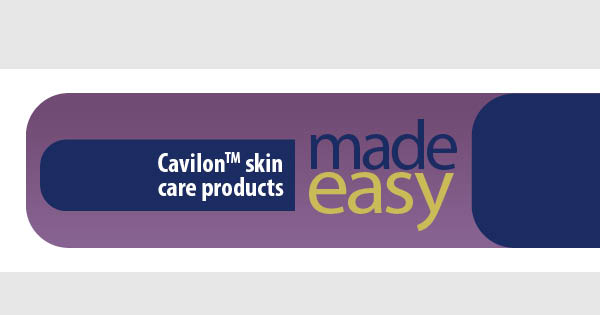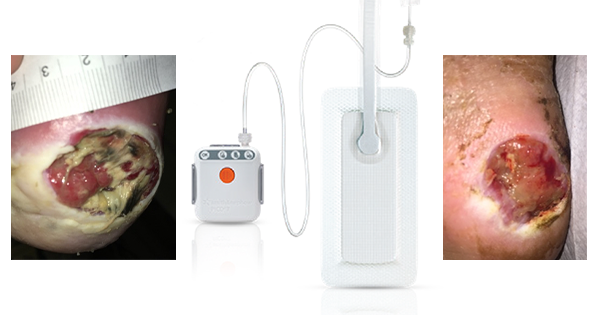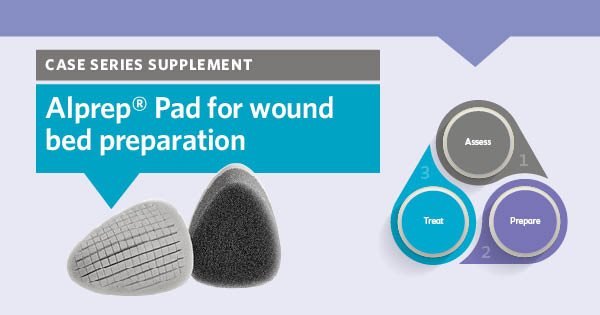Skin breakdown is common and may herald a wide range of potentially serious and debilitating complications, such as the development or enlargement of open wounds and increased risk of infection. Among the most challenging and concerning causes of skin breakdown are incontinence and periwound moisture. Prevention of skin breakdown in these situations requires excellent management of the predisposing cause and protection of vulnerable skin. Skin protectants ideally need to be effective, easy and comfortable to apply, long lasting and cost effective. This article details the characteristics and uses of the 3MTM CavilonTM range of skin care products that has been developed to protect vulnerable skin and prevent skin breakdown.
What are Cavilon skin care products?
The Cavilon range of products for skin protection includes:
- Cavilon no sting barrier film
- Cavilon durable barrier cream
- Cavilon durable barrier cream + honey
Cavilon No Sting Barrier Film
Cavilon no sting barrier film is an alcohol-free liquid that, when applied to skin, dries quickly to form a protective transparent acrylate terpolymer coating on the skin, which is water repellent and conformable. (Table 1 illustrates the differences between traditional and liquid barrier film-based barrier products.)
Cavilon no sting barrier film is designed to protect damaged or ‘at risk’ skin from urine/faeces and other body fluids (such as wound exudate), and also from adhesive trauma and friction. It is sterile and can be applied to both intact and damaged skin.
The film is hypoallergenic, non-cytotoxic and has been developed to be non-sting, even when applied to damaged tissue. It has been clinically proven to protect skin from the effects of incontinence for up to 72 hours (Houser et al, 2010).
Cavilon Durable Barrier Cream
Cavilon durable barrier cream provides long-lasting protection of the skin from bodily fluids, and also acts as a moisturiser/emollient. The protective barrier is provided by 1.3% dimethicone and acrylate terpolymer. Together they form a thin, durable, protective film on the skin, which can be used to prevent breakdown of intact skin. It is highly concentrated and should be applied in smaller amounts than traditional barrier creams.
Like Cavilon no sting barrier film, the cream will not transfer to underwear or incontinence pads, and is resistant to washing off, eliminating the need for frequent reapplication. Unusually for a cream, it allows tapes and dressings to adhere and, as with all Cavilon skin care products, it has been tested for hypoallergenicity.
Cavilon Durable Barrier Cream + Honey
Cavilon durable barrier cream + honey is a new product in the range. It has the same general indications as Cavilon durable barrier cream, but may be more suitable for patients with sensitive skin as the honey acts as a natural preservative, replacing parabens and perfumes, which are common sensitisers in some patient groups.
Sensitisation to parabens and perfumes
The incidence of sensitisation of patients to topical wound care formulations has been examined in a number of studies. Wilson et al (1991) found that around 15% of leg ulcer patients showed positive patch tests results for preservatives. More recently, Tavadia et al (2003) found that many leg ulcer patients were allergic to fragrances and also to creams containing preservatives.
It is now recognised that patients with leg ulceration have a higher susceptibility to contact dermatitis than other patient groups (Beldon, 2009) and it is important to have low allergen alternatives for this patient population.
The need for skin protection
The skin is the largest organ of the body and provides a number of important functions, including acting as a vital barrier between the body and the external environment (Woo et al, 2009). Damage to the skin compromises the barrier, and can have a range of effects, including discomfort, and increased risk of infection and further skin breakdown. A wide range of factors can increase the vulnerability of skin to damage. Excessive moisture on the skin surface and dryness of the skin are among the most common factors (Gray et al, 2011; White-Chu et al, 2011).
Faecal and/or urinary incontinence are experienced by more than half of people living in nursing homes (Zimmaro Bliss, et al 2006). Incontinence-associated dermatitis (IAD), also known as moisture lesions, is a painful skin condition characterised by irritation and inflammation. IAD occurs when the perineal or perigenital skin comes into prolonged contact with urine, faeces or a combination of both resulting in tissue breakdown, and increased risk of infection and pressure ulcers (Ermer-Seltun, 2011). In turn, these effects may have a major impact on an individual’s physical and psychological wellbeing. Therefore, avoiding or minimising skin damage that may result from incontinence is imperative (Bianchi, 2011).
Periwound skin damage can occur around chronic wounds as a result of excessive moisture due to wound exudate and/or damage from inflammatory enzymes in the exudate (Williams, 1998; WUWHS, 2007). The resulting degradation of keratin compromises the barrier function of the periwound skin and can result in further skin breakdown that may enlarge the wound (Guest et al, 2011; Cameron et al, 2011).
With age, the skin becomes thinner, loses collagen and elastin and there is a reduced blood supply. This results in the skin becoming more fragile and easily damaged (Figure 1). The reduction in sebum production that comes with old age often means that the skin becomes dry and flaky, which may cause itching that leads to scratching and excoriation (Ratliff and Fletcher, 2007). The dryness combined with reduced skin flexibility may also allow cracks to occur that can be colonised by bacteria, and increase the risk of damage due to shear and friction (Bianchi and Cameron, 2008; Ratliff and Fletcher 2007). Moisturising skin to reduce dryness may help to reduce the risk of breakdown and enhance the skin health of patients (Stephen-Haynes, 2011).
When are Cavilon products indicated?
Cavilon no sting barrier film is indicated for use on intact and broken skin to protect the skin from contact with bodily fluids and to prevent further breakdown. The main indications are skin breakdown due to IAD and periwound skin protection (see Table 2). The product also has a role in protecting skin from stripping due to adhesive devices such as tapes and stoma discs. It does not contain alcohol and so does not sting when applied to broken skin.
Cavilon durable barrier cream is indicated for use on intact or irritated skin to prevent the development of skin breakdown associated with incontinence. The cream can also be used as a moisturiser for severely dry skin.
Cavilon durable barrier cream + honey works in the same way as Cavilon durable barrier cream, but may be more suitable for patients with sensitive skin or if there is known or suspected allergy to parabens (preservatives) and perfumes.
Contraindications and precautions
Cavilon products are contraindicated on infected areas of the skin, eg areas with fungal infection. More than one Cavilon product should not be used simultaneously on the same area of skin.
Cavilon skin care products should not be used on patients who are sensitive to any of the ingredients. Cavilon durable barrier film and Cavilon durable barrier cream + honey do not contain parabens or preservatives and are suitable for patients who are sensitive to these ingredients.
Role of Cavilon Durable Barrier Cream + Honey in lymphoedema patients
Cavilon durable barrier cream + honey can be used on patients with lymphoedema as a barrier cream to prevent compression garments (eg compression sleeves and hosiery) from rubbing against sensitive areas, such as elbows and knees. The product can be applied to the skin under the garment to prevent abrasion or to protect fragile skin. The product may also be helpful when garments are slipping. A layer of cream can be applied around the top of the sleeve or stocking to help it to stay in place and may provide an alternative to using tape or a stockinette.
Patients with lymphoedema develop skin changes as a result of their condition. Many of these problems can be improved by an appropriate skin care regimen to ensure the barrier function of the skin is maintained. A thin coating of Cavilon durable barrier cream + honey may be particularly useful in patients with severe swelling to protect irritated skin in creases and skin folds (e.g. where breast oedema is a problem).
Tip: Cavilon durable barrier cream is not a replacement for a general moisturiser and it is very important to ensure patients do not stop using their usual skin care products
How to apply Cavilon products
Cavilon no sting barrier film
Cavilon no sting barrier film comes in a variety of easy to apply formats, including impregnated foam applicators (wands), pump spray and stoma wipes. Each application will last for up to 72 hours and will not sting, even when applied to broken, excoriated skin.
- Skin should be clean and dry prior to application
- Apply a uniform coating of the film over the entire treatment area when using the foam applicator
- When using the spray bottle, hold the spray nozzle 10-15cm away from the skin and apply in a smooth, even coating over the entire treatment area while moving the spray in a sweeping motion
- If an area is missed, reapply to that area only after the first application has dried (this will take approximately 30 seconds)
- If Cavilon no sting barrier film is applied to an area with skin folds or where there is other skin-to-skin contact, make sure that the skin contact areas are separated and allow the coating to dry before returning skin to the normal position
- Reapplication is recommended every 48-72 hours under normal use, or more frequently as required. If used around a stoma, reapplication is needed after each adhesive dressing/stoma pouch change.
Cavilon durable barrier cream
- Cavilon durable barrier cream comes in a tube or sachet format. Cavilon durable barrier cream + honey comes in a tube format only. Both creams should be applied as follows:
- The skin should be clean and dry prior to application of Cavilon durable barrier cream and Cavilon durable barrier cream + honey
- Apply the cream sparingly, in successive pea-sized amounts, to cover the entire affected area, and rub in gently until the cream is absorbed
- If the skin feels oily too much cream has been applied and should be reduced at the next application
- Reapplication is recommended at every third episode of incontinence
- When used to moisturise severely dry skin, apply daily or more often as needed.
Removal of Cavilon products
Cavilon no sting barrier film will wear off naturally and complete removal is not required before application. However, in the rare circumstances where removal is required, standard medical adhesive removers may be used. Alternatively, the film may be removed by the application and immediate removal of an adhesive tape (e.g. 3MTM MicroporeTM Surgical Tape).
Tip: Removal of Cavilon durable barrier cream and Cavilon durable barrier cream + honey is not necessary before reapplication
When to discontinue Cavilon products
It is important to monitor patients regularly for signs of improvement or deterioration of the skin. Cavilon skin care products should be discontinued when the primary objective for their use has been achieved or when there is improvement in the patient’s symptoms or condition. This may be when incontinence ceases to be a problem or when wound exudate levels or periwound protection is no longer required.
Safety and tolerability of cavilon products
The durability of Cavilon no sting barrier film and three other barrier film products was assessed over a 72-hour period. Activated carbon powder was used as a marker of the efficacy of the barrier films at preventing wash-off and wear-off. The study indicated that Cavilon no sting barrier film was more than twice as effective at preventing wash-off and wear-off of a marker substance than the other barrier films tested (Houser et al, 2010).
In a further study by Lutz and LaVoie (1999) comparing the efficacy of four moisture barrier creams, Cavilon durable barrier cream was found to provide superior protection, while two of the four products tested did not provide a moisture barrier when first applied to the skin.
The sting potential of Cavilon no sting barrier film was assessed along with four other film-forming protectants (Schwartzmiller et al, 1994). The researchers found that alcohol-based barrier films caused severe pain when applied to freshly stripped wounds. In the group treated with the alcohol-free Cavilon no sting barrier film, results were statistically equivalent to the saline negative control, and the product did not cause pain when applied.
Evidence for Cavilon products
Cavilon no sting barrier film and Cavilon durable barrier cream are established skin protectants that have been investigated in a number of key clinical studies over the years (Table 3). These studies have confirmed that Cavilon no sting barrier film and Cavilon durable barrier cream are at least as effective as traditional skin protectants in preventing IAD and periwound skin breakdown, and may have a role in the prevention of pressure ulcers (Guest et al, 2011; Schuren et al, 2005; Bale et al, 2004; Parnum, 2011).
Availability in the uk
Cavilon products are available through the NHS Supply Chain. For community use, the products can be found in Part IXC (Skin Fillers and Protectives) of the Drug Tariff.
Cost benefits of a skin care protocol
A number of studies have reviewed the cost-effectiveness of using periwound skin protectants in patients with venous leg ulcers (Cameron et al, 2005) and in incontinent patients in nursing homes (Bale et al, 2004). A study by Bliss et al (2007) on the implementation of a skin care regimen that included a cleanser and a moisture barrier for preventing IAD resulted in significant cost savings for nursing homes in the USA. A recent review found Cavilon no sting barrier film was at least as clinically effective and potentially more cost-effective in IAD prophylaxis and periwound skin protection than petroleum ointments or zinc oxide formulations (Guest et al, 2011).
Large (2011) describes the introduction of a pressure ulcer prevention strategy at a 78-bed nursing home in the UK. Cavilon durable barrier cream was chosen for incontinent patients and an aqueous cream was used as a soap substitute. Dermal pads were used for patients at risk of pressure ulcers. Only small changes were made to daily practice, yet the outcome was significant – the incidence of pressure ulcers was eliminated during the study period. This also led to a reduction in the costs for ongoing wound care. These results, and those by Parnum et al (2011), have important implications for meeting the QIPP/CQUIN challenge for pressure ulcer reduction in the UK.
Summary
The Cavilon range of skin care products provides safe, easy to use, and effective skin protection that can help to reduce incontinence-associated dermatitis, peri-wound skin breakdown and pressure ulcer development. Cost-effectiveness data have also indicated that the Cavilon range can reduce costs when compared with traditional barrier products and can contribute to achievement of CQUIN targets.
References
- Bale S, Tebble N, Jones V, Price P. (2004).The benefits of implementing a new skin care protocol in nursing homes. J Tissue Viability 14(2): 44-50.
- Beldon P (2009). Avoiding allergic reactions in skin. Wound Essentials 4: 46-51.
- Bianchi J (2012). What are the causes of moisture lesions and the strategies for treatment? Nursing Times 108(5):20-22.
- Bianchi J, Cameron J (2008). Management of skin conditions in the older population. Br J Community Nurse 13(9):S6, S8, S10
- Bliss DZ, Zehrer, Savik K, et al (2007). An economic evaluation of four skin damage prevention regimens in nursing home residents with incontinence. J Wound Ostomy Continence Nurs 34(2):143-52.
- Cameron J, Hoffman D, Wilson J, Cherry G (2005). Comparison of two peri-wound skin protectants in venous leg ulcers: a randomised controlled trial. J Wound Care 14(5): 233-36.
- Ermer-Seltun J (2011). Practical prevention and treatment of incontinence-associated dermatitis – a risk factor for pressure ulcers. Ost Wound Manage Available at: http://www.o-wm.com/content/practical-prevention-and-treatment-incontinence-associated-dermatitis-%E2%80%94-risk-factor-pressure (accessed 23 November 2011).
- Gray M, Black JM, Baharestani MM, et al (2011). Moisture-associated skin damage: overview and pathophysiology. J Wound Ostomy Continence Nurs 38(3): 233-41.
- Guest JF, Greener MJ, Vowden K, Vowden P (2011). Clinical and economic evidence supporting a transparent barrier film dressing in incontinence-associated dermatitis and peri-wound protection. J Wound Care 20(2):76, 78-84.
- Houser T, Grove GL, Zerweck C (2010). A comparison of the durability of four barrier film products over a 72-hour period on human volunteers. Poster presentation at Advances in Skin and Wound Care (ASWC).
- Large J (2011). A cost-effective pressure damage prevention strategy. Br J Nurs (Tissue Viability Suppl) 20(6): S22-5.
- Lutz J, LaVoie K (1999). Comparison of the effectiveness of four dimethicone-based moisture barrier creams. 3M Health Care. Data on file.
- Parnum J et al (2011) Evaluation of a durable barrier cream in relation to pressure ulcer prevention in incontinent patients, an economic argument. Poster, Wounds UK conference, Harrogate.
- Ratliff CR, Fletcher KR. Skin tears: a review of evidence to support prevention and treatment. Ostomy Wound Manage 2007; 53(3): 32-42.
- Schwartzmiller DH, Lutz JB, Grove GL (1994). Measuring sting potential of various film forming skin protectants. Poster presentation at the Symposium of Advances in Skin and Wound Care (SAWC).
- Schuren J, Becker A, Sibbald RG. A liquid film-forming acrylate for peri-wound protection: a systematic review and meta-analysis (3M CavilonTM no-sting barrier film). Int Wound J 2005; 2(3): 230-38.
- Stephen-Haynes J (2011). Skin damage: management in the older person. Wound Essentials 6: 40-43.
- Tavadia S, Bianchi J, Dawe M et al (2003). Allergic contact dermatitis in venous leg ulcer patients. Contact Dermatitis 48:261-65.
- White-Chu EF, Reddy M (2011). Dry skin in the elderly: Complexities of a common problem. Clinics Dermatol 29(1): 37-42.
- Williams C. 3M Cavilon No Sting Barrier Film in the protection of vulnerable skin. Br J Nursing 1998; 7: 613-15.
- Wilson CI, Cameron J, Powell SM et al (1991). High incidence of contact dermatitis in leg ulcer patients – implications for management. Clin Exp Dermatol 16:250-253.
- Woo KY, Ayello A, Sibbald RC (2009). The skin and periwound skin disorders and management. Wound Healing Southern Africa 2(2): 1-6.
- World Union of Wound Healing Societies (WUWHS). Principles of best practice: Wound exudate and the role of dressings. London: MEP Ltd, 2007. Available at: http://www.woundsinternational.com (accessed 23 November 2011).
- Zimmaro Bliss D, Zehrer C, Savik K, et al (2006). Incontinence-associated skin damage in nursing home residents: a secondary analysis of a prospective, multicenter study. Ostomy Wound Manage 52(12): 46-55.
AUTHOR DETAILS
Bianchi J[1], Hardy D[2]
- Medical Education Specialst and Honorary Lecturer College of Medical, Veterinary and Life Science, Glasgow University, Scotland
- Clinical Nurse Specialist, Kendal Lymphology Centre, Cumbria







